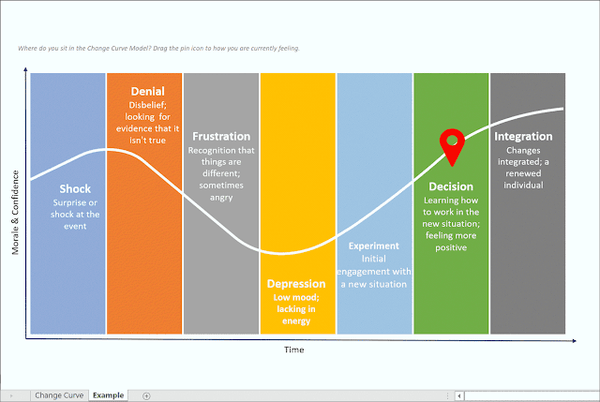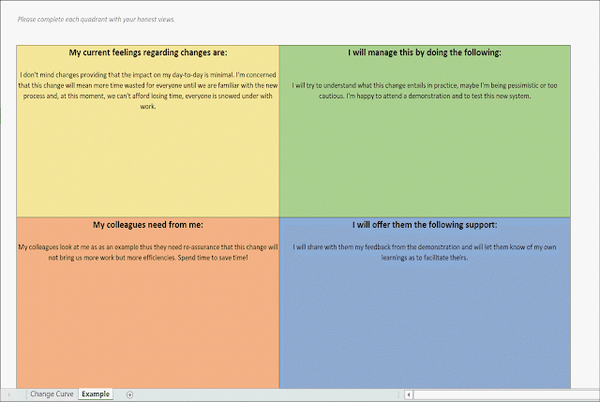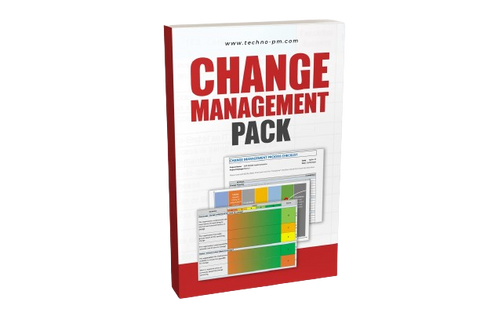Change Curve | Download Change Curve Model Template
Change Management
How many times have you seen this happening? You put new software in, prepare plenty of guidance, issue a newsletter about the new system every month, provide extensive training to everyone involved, and yet…no one is using it.

Change Curve
The thing is, organizations don’t just change because of new systems or structures – they change because people change. Only when people have been through their own change paths will the benefits of change in the organization become visible.
The way change is perceived by each of us differs but, whether faster or slower, we all go through the same stages when experiencing change. However, many organizations still fail to acknowledge and effectively manage this transition, instead of focusing on the systems and processes rather than on managing the people side of change. Make no mistake: the individual journey of change matters.
The Change Curve
Conscious of the importance of managing change at the individual level, Kubler-Ross developed, in the 1960s, a tool that has become one of the most popular and powerful models for change management: the change curve.
The change curve plots the motivation and performance of individuals over time, and it helps build an understanding of where everyone is in their journey and why they might be responding to change the way they are.
Following, it can be a very useful tool for managers or for anyone introducing change as a way to anticipate a certain behavior/response and to prepare an appropriate plan of action, providing all the support they need for a smooth transition.
In fact, it should be noted that, while well-known in a business setting, the change curve model can also be applied at a personal level – for instance, it can be used to represent periods of grief.
The Stages of the Kubler Ross Change Curve
The model has been adapted since its development, and recent versions now tend to include up to 7 stages which people will go through, in order, namely:
1. Shock: after a disturbing event happens, people’s first reaction will be one of shock, which can even include the blame of others or the self. In this stage, people might feel lost, not knowing what to do next.
2. Denial: This stage often is present as an instinctive mechanism of defense. Coping with high-impact change might lead to disbelief, that is, a conscious decision not to accept that the change happened indeed.
3. Frustration: refers to a moment of high uncertainty after the acknowledgment of the change event. People are very emotional during this stage, and conflict can arise very easily. There is a sense of frustration where people question the reason behind the change.
4. Depression: This stage is where performance and motivation are at their minimal levels, such as the state of despair and unhappiness about the change. Individuals are cognizant of the change, but they would prefer not to implement it in their lives.
5. Experiment: the appetite to experiment with the new world, post-change event, is a turning point in the change curve model since the motivation and performance slowly and gradually start to increase. The individual is open to give it a try.
6. Decision: this stage represents a conscious moment in the change curve when the individual decides to be part of the change and assimilate the new ways of working in his/her day-to-day.
7. Integration: the final stage in the change curve refers to the full embeddedness of change when the change has become the new normal for the individual.

Change Curve Model Template
Who and Where Can Change Curve Model Be Used
The change curve model can be used at any point in the change implementation, and it is a fundamental input to build the stakeholder engagement and communications plan. While it can be used for self-assessment, individuals might find it difficult to recognize some traits since they will be too immersed in their own experience of change.
Thus, a change manager practitioner or the individuals’ manager can better utilize it, who can then put plans to accelerate how people progress through the course or make it an as painless as possible process. For instance, this can include allowing time off to reflect, providing guidance to move from the stage of frustration to experimentation, or granting opportunities to interact with the change and, in this way, facilitating the decision to assimilate change.

Conclusion-
No matter how small, any change, and any person, no matter how experienced in change, will go through the change curve. Even with all the support in place, going from one stage to the other takes time, and that transition should not be rushed, nor should stages be skipped. Change demands time.




